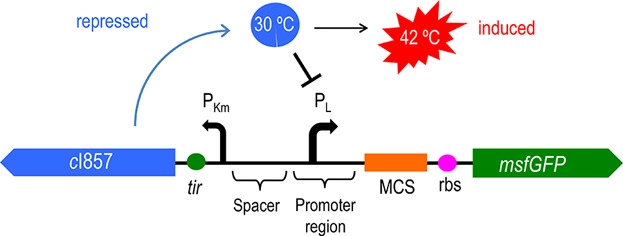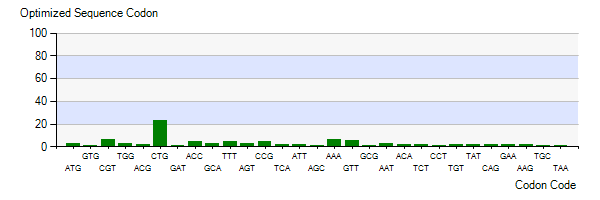Part:BBa_K4182011:Design
Temperature regulated suicide circuit
- 10INCOMPATIBLE WITH RFC[10]Illegal prefix found in sequence at 1018
Illegal suffix found in sequence at 1446 - 12INCOMPATIBLE WITH RFC[12]Illegal EcoRI site found at 1018
Illegal SpeI site found at 1447
Illegal PstI site found at 1461
Illegal NotI site found at 1024
Illegal NotI site found at 1454 - 21INCOMPATIBLE WITH RFC[21]Illegal EcoRI site found at 1018
Illegal XhoI site found at 2478
Illegal XhoI site found at 3504 - 23INCOMPATIBLE WITH RFC[23]Illegal prefix found in sequence at 1018
Illegal suffix found in sequence at 1447 - 25INCOMPATIBLE WITH RFC[25]Illegal prefix found in sequence at 1018
Illegal XbaI site found at 1033
Illegal SpeI site found at 1447
Illegal PstI site found at 1461 - 1000COMPATIBLE WITH RFC[1000]
Profile
Base Pairs
3733
Design Notes
This gene has been optimized for E. coli
Source
Escherichia phage phiX174(from https://www.ncbi.nlm.nih.gov/gene/2546400)
Usage&Biology
Design new suicide circuits for engineering efficiency and biosafety reasons
To facilitate the modularized design of plasmids, we named the EPS synthesis verification plasmid 4, which will be referred to as plasmid 4 in the following paragraphs.
Source and Principle
Biosafety is an important consideration when designing engineered bacteria. From the beginning, we designed the bacteria on the premise that it would work in the field soil, so we first needed to consider whether our product could be easily controlled for the time of its operation and whether there were potential risks to soil structure, crop growth, and the balance of soil microbiota. So we designed a "suicide system" at the genetic level to ensure that our engineered bacteria would not pose a potential biosecurity risk to the ecological environment.
The suicidal behavior of bacteria is a common phenomenon in nature, which is a programmed death mechanism of prokaryotes. quorum sensing (QS) is a form of communication between bacterial cells. Cells synthesize and secrete signal molecules. When the concentration of signal molecules in the environment reaches a certain threshold, a series of genes are activated, and the bacterial population synchronously realizes certain functional and behavioral changes. A quorum-sensing suicide gene circuit has been constructed, and the systematic study and precise regulation of this gene circuit are of great significance both in theory and application [1].
In addition to population-responsive suicide mechanisms, suicide systems with other regulatory modes can also be designed through synthetic biology. Here, we designed a temperature-responsive cleavage system to achieve temperature-controlled cleavage, that is, cleavage of thermoregulated lysis genes (Gene ID: IF654_RS00240) (Figure 1).
Figure 1: Circuit diagram of plasmid 5: Where CI is the C1857 suppression subsystem, Pλ is the promoter, and the temperature control system is in the dashed box.
Figure 2 shows the principle of the temperature control system [4]. When bacteria are at a low temperature, the c1857 gene expression protein binds to the Pλ promoter, making downstream genes unable to be translated. At 42℃, the protein will be cleaved, leading to the expression of downstream genes.
In conclusion, we wanted to take advantage of temperature changes as a variable environmental signal, allowing our engineered bacteria to function at lower temperatures and Lysis proteins to lysis the engineered E. coli cells at higher temperatures, resulting in control of the engineered bacteria and release of the product.
Codon improvement and optimization
The Lysis gene we used was expressed in Pseudomonas lundensis. To better express the Lysis gene in engineered bacteria, we optimized the codon of the Lysis gene according to the codon preference of Escherichia coli. Figure 5-3 shows the number of codons we optimized to make our codons more in line with Escherichia coli preference. The modified Lysis gene is shown in BBa No.K4182007.
Figure 3: Optimized Sequence Codon in plasmid Ⅴ
Plasmid design and improvement
Initially, based on the design of the assay protocol, we planned to construct plasmid 5 (FIG. 4) using plasmid pSB1K3 as the skeleton and lysis gene + temperature regulator mode.
Figure 4: Plasmid 5 map based on pSB1K3
However, in our subsequent experiments, it was found that when the plasmids designed in this way were transferred to DH5α cells after Golden Gate cloning for expression, only dark target bands could be observed in colony PCR (Figure 5), and the extraction of plasmids and sequencing could not be completed due to the low concentration
Figure 5: PCR results of plasmid 5 colonies based on pSB1K3. The target band is approximately 1600bp long and is marked by blue arrows
Therefore, we judged that due to the insufficient copy amount of pSB1K3 plasmid, we could not extract the product with a sufficient concentration in the engineered bacteria.
Therefore, we replaced the vector of plasmid 5 with pSEVA341, which had a higher number of copies, and redesigned the plasmid (Figure 6).
Figure 6: Map of modified plasmid 5
Experimental verification
Colony PCR
After the primer design was completed, the fragments were connected by Golden Gate ligation and transferred into competent DH5α cells, which were cultured in the medium containing chloramphenicol. The primers were designed for colony PCR, and obvious target bands were observed (Figure 7). The sequencing results were correct
Figure 7: PCR results of plasmid 5 colonies after vector change. The target band is marked by a blue arrow
References
1. Din, M.O., et al., Synchronized cycles of bacterial lysis for in vivo delivery. Nature, 2016. 536(7614): p. 81-85.
2. Saeidi, N., et al., Engineering microbes to sense and eradicate Pseudomonas aeruginosa, a human pathogen. Mol Syst Biol, 2011. 7: p. 521.
3. Restrepo-Pineda, S., et al., Thermoinducible expression system for producing recombinant proteins in Escherichia coli: advances and insights. FEMS Microbiol Rev, 2021. 45(6).
4. Aparicio, T., V. de Lorenzo, and E. Martínez-García, Improved Thermotolerance of Genome-Reduced Pseudomonas putida EM42 Enables Effective Functioning of the PL/cI857 System. Biotechnology Journal, 2019. 14(1): p. 1800483.







